Passion flower. Photo by Myriam B. Mahiques
The beautiful Passion Flower. http://auntiekate.files.wordpress.com/2008/12/passionflower.jpg
The Passion Flower is also known as Pasionaria, Flor de la Pasión, Maracuiá, Maracoc, Passiflora, Granadilla. Its genus name is passiflora, a naturally grown medicinal herb, for the treatment of insomnia and nervous disorders used as a sedative. The plant is indigenous to an area from the southeast U.S. to Argentina and Brazil. In South America there are approximately 95% of the five hundred species. A vigorous and rapid climber, it supplies shade, color, nectar, and fragrance all year. Specific butterflies are attracted by its nectar and pollen. There are dozens of passion vines, both edible and non edible. The most popular, is Passiflora edulis. Its fruit is eaten fresh or used in drinks, pies, jams, and ice cream.
Dominican monk Simone Parlasca's drawing of a passion flower in a pamphlet dated 1609, Bologna. Kugler and King (2004) say that this was probably based on original dried plants. Poems in the pamphlet related the flower to the "Fiore della Granadiglia overo della passione di nostro Signore Giesu Christo." (Courtesy of Leslie A. King). Exerpt from http://www.flwildflowers.com/clues/parlasca1609.jpg
Eugenio Petrelli depicted this flower in 1610 as a frontispiece in a book by Antonia Possevino, write Kugler and King. This was a form that was widelyused in pamphlets of the time. (Courtesy of Leslie A. King). Excerpt from www.flwildflowers.com/clues/
Europe owes this vine to Columbus. This flower must have presented a great coloured picture to the Misioneros. From Lesley Gordon´s book, ¨Green Magic¨ we learn that ¨in their religious zeal, the Spaniards saw in this flower a God-given symbol of Christ´s Passion, and hailed it as an assurance of the ultimate triumph of the Cross. Every part of the flower, leaf and stem seemed to be clearly designed for the purpose. It was pointed out to the natives that the leaf was a symbol of the spear, and the five anthers, the five wounds; and so the converted Mexicans called it Flor de las Cinco Llagas, The flower of the Five Wounds. The tendrils were likened to the cords and whips, and the column of the ovary to the pillar of the Cross. The stamens symbolized the hammers, and the dark circle of threads –the dramatic center of this extraordinary flower- the crown of thorns. The calyx represented the nimbus, and if the flowers were white it denoted purity, and if they were blue, heaven. The three days that were the life-span of the flower meant that so shall ¨the Son of man be three days and nights in the heart of the earth.¨
Picture from http://www.virtualherbarium.org/GardenViews/passionvines.html
And so it was called Flos-passionis, changed by Linnaeus into Passiflora, the Passion Flower. It was thus held in veneration in South America, and nuns trained it round their dormitory windows. The flesh-coloured Passion Flower, P. incarnata, was the first species known in Europe, and it was introduced into England in 1629…..The common blue, P. caerula, which thrives in the open, arrived in 1690. ….By the eighteenth century the flowers legends lose their simplicity. They are moral but contrived.¨ (Lesley Gordon, 1977).
Drawing by Johann Zahn (1631- 1707), a canon of the Church in Wurzburg, was also a scientist an inventor of the camera obscura which let artists trace three dimensions on two dimensional board. Credit the National Oceanic and Atmospheric Administration Library in Silver Spring, Maryland for this picture from the rare Zahn book. From www.flwildflowers.com/clues/
The religious symbolism associated with the Catholic Church waned with the onset of Protestantism and the advent of scientific thought. Other exotic plants were found in America. Allegories of the crucifixion were imagined in the roots or stems of other species. The religious metaphor in botany was part of the Spanish conquest imaginary needed to teach Catholic beliefs to Indians.
Panel of the Carved Pulpit, by Editha R. Plowden. From chestofbooks.com
The beauty of the Passion Flower is also represented in ornaments as carvings, stained glass, arts and crafts, wrought iron, among other designs.
Modern design of stained glass with Passion Flower. http://chantalstainedglass.50megs.com/3passifloraoval_btn.jpg
The Passion Flower at St Mary’s in France.The stained glass windows on the south side of the chancel contain the passion flower, cross and crown theme which has inspired the other items. www.gillinghamanglican.org.uk/history/
The passion flower sculpted in a cross. Green Wood Cemetery. From
Modern design with Passion Flower. www.commercial.shawinc.com
http://www.virtualherbarium.org/GardenViews/passionvines.html
Abrams, Michael E. Clues to the mystery: Early passion flower depictions compared to Joos van Cleve's 'Mystery Artist' Madonna; a 1640s painting by Albert Eckhout; some interesting history about the early herbals and authors
www.flwildflowers.com/clues/
Gordon, Lesley. Green Magic. The Viking Press, New York. 1977












Everything comes if a man will only wait.
ReplyDelete.
.
.
.
.
.
.
.
.
.
.
.
.
.
.
.
.
.
.
.
.
.
.
.
.
.
.
.
.
.
.
.
.
.
.
.
.
.
.
Me encanta la flor de Mburucuya, pronto van a florecer los que están en Buenos Aires. Excelentes las imagenes que conseguiste
ReplyDeleteGracias Ana!
ReplyDeleteUn beso,
Acá me comenta mi mamá que la pasionaria aparece entre los motivos que decoran el piso de la Catedral de Buenos Aires
ReplyDeleteGracias a tu mamá Ana, tengo que postear esa foto de la catedral. Tantas veces he estado en la Catedral y nunca lo noté, embelesada con la arquitectura y el imaginario.
ReplyDeleteUn beso,